Description
Joseph Haydn
Quartet in F minor, Op. 20, Nr. 5, Fuga a due soggetti
Orchestrated by David Whitwell
Instrumentation: Concert Band
Difficulty: Grade 4
Duration: 5:20
Year: 1772, orchestrated 2021
Performance Notes
On an occasion of rereading H. C. Robbins Landon’s fine book, Essays on the Viennese Classical Style, I was surprised by his comments about this movement.
Haydn’s quartet in F minor ends with a fantastic Fuga a due Soggetti (double fugue) marked sempre sotto voce (literally always in a soft voice), which gives the whole ghostly and definitely sinister overtones. Beethoven used this for one of his models when he was experimenting with contrapuntal forms prior to composing the Grosse Fuge.
The reader may be surprised to read of such descriptions as “ghostly” and “sinister” associated with the music of Haydn. However, Haydn had on occasion the ability to produce very surprising works, such as the Harmoniemusik works he wrote for use by his first aristocratic employer and his friends to slurp their soup — music based on the Catholic Chant for the Dead, or the overture he wrote in retirement after he decided he needed a new overture to Part II of his Creation, a wind band work sounding more like Bruckner.
In any case, Robbins Landon’s description of “ghostly” and “sinister” sent me to the library to see this music by Haydn. What one sees on paper is a standard Baroque church fugue, with no string idioms whatsoever. Furthermore, a double fugue with entries of the two subjects presented in various registers is quite difficult to appreciate when played by only four players, three of which have very similar tone qualities. One performance I heard by a string quartet not only had this disadvantage, but was also a performance which ignored the “sempre sotto voce” which Haydn took time to write and, thinking of the work as the last movement of a quartet, they performed it very fast, trying to make it sound like a “Finale.”
These problems caused me to think of scoring this fugue for wind band, which would make it possible to have the variety of colors necessary to help the listener hear the many entrances of a fugue with two subjects. Furthermore, since on paper one sees a church fugue with no string idioms, it reminded me of the fact that the church organ at this time was still a surrogate wind band, the vibrating soupy string sounds which are so familiar in organ performance today were stops which only appeared later in the 19th century, long after the life of Haydn.
The one performance issue which I should like to mention is one still unknown to many musicians, and that is the fact that the dot over a single note at this time in Central Europe meant not staccato, but rather an accent. Accordingly, these dots which appear in the second subject I have replaced with accent symbols, which also give more drive forward than the bow bouncing off the string in trying to make staccato at a fast tempo.
David Whitwell, 2021
Austin, Texas






